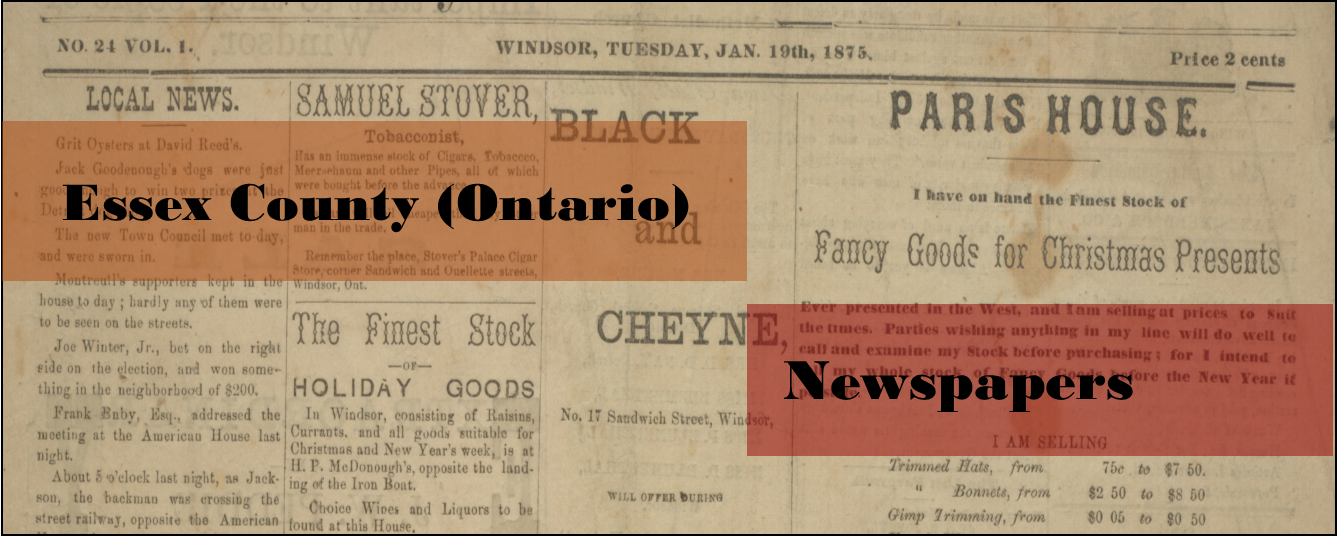
Files
Download
Download Full Text (13.3 MB)
Place of Publication
Essex, Ontario
Description
Title Variations
Essex Chronicle
Chronicle
Essex Center Chronicle
Publication Dates
1878? - 1885
Frequency
Weekly
Online Holdings
1880: Aug. 27 (Vol. 2: no. 26) (Whole no. 78) 8p.
Keywords
Newspapers, Essex (Ontario), Essex County (Ontario), Essex Centre Chronicle, Essex Chronicle, Essex Center Chronicle
Disciplines
Canadian History | Public History
Rights
Public Domain


Comments/Notes
There is a detailed, and fairly accurate, description of the Essex Centre Chronicle in the publication: Brief Sketch of the County of Essex in the Province of Ontario, Canada, by J. E. Johnston (1889), page 27: "The first paper published in Essex Centre was The Chronicle, the first number of which was issued in May, 1879, by Robt. Fair, of Leamington. It was published as a four-page sheet with "patent outside". The Chronicle was sold to John Milne in the fall of 1879, who continued to run it for a number of years, R. A. Hughes, J. E. Copus, and John Curran being at various times editors. Mr. Milne also started the Canadian Workman, the official organ of the A. O. U. W. which was printed in Essex Centre for some time. On June 18th, 1880, Mr. Milne changed the size and shape of the Chronicle to an eight page, 5 column paper. Mr. Curran bought the paper from Mr. Milne in July 1882, and continued to run it as proprietor until 1884, when he sold out to Mr. A. E. Lovelace. Meanwhile, the Advance had been started in 1882 by Mr. John Stafford. This paper was carried on by him until 1885. At the beginning of that year, Messrs. George Laing and John Stafford bought The Chronicle from Mr. Lovelace and amalgamated the two papers, changing the name to The Argus."
Based on the numbering of the extant issue, the description of the newspaper in the American Newspaper Directory by Rowell (1883 and 1884), and also a newspaper article in the Windsor Evening Record (1904: Jan. 23, pages 3 and 7), the Essex Centre Chronicle appears to have started publishing either late 1878 or early 1879 (rather than May 1879). After June 1880, it measured approximately 26 x 40 inches, had a circulation of at least 1,000 copies per issue, and appeared "every Friday morning in time for the trains and stage going east and west" (page 4).
Its motto was: "No prejudice, no partiality, but justice to all". Unlike many small newspapers of the era, the Chronicle did seem to be quite neutral in its reporting. The focus of its content was on general and council news from all the Essex County towns and villages. There was also some Canadian and international news, classified advertisements, and extensive business advertising.
John Milne is considered to be the founding father of the town of Essex. He was born in 1838 in Aberdeen, Scotland, and came to Canada as a young child. In the Summer of 1873, he took up residence in the tiny hamlet of Essex Centre, and built up many businesses. According to his memoirs, he constructed a two-storey building on Talbot Street in 1878 (later replaced by a three-storey brick building in 1884). He persuaded Robert Fair of Leamington to install a printing press and all the machinery needed to publish a newspaper. Robert Fair was part owner and editor of the Leamington Post. Robert Fair published the Chronicle for a short period before selling it to John Milne. The building on Talbot Street was known as the Essex Centre Manufacturing Company and later as the Essex Industrial Works. In addition to a power plant, foundry, machine shop and other industrial endeavours, Milne also had a large banking and real estate business. He became Clerk of the 8th Division Court in 1875, Justice of the Peace in 1878, and served as Mayor of Essex from 1889 to the mid-1890s. He died in Essex on September 23rd, 1931 at the age of 92.
John Jones Curran was born in Armagh, Ireland in 1839. He came to Canada in 1873 and started work as an editor of the Essex Centre Chronicle about 1880. In July 1882, he bought the paper (and also the newspaper: Canadian Workman) from John Milne. He continued to publish both newspapers in Essex Centre until 1884, when he sold the Chronicle to A. E. Lovelace. John Curran then moved to Orillia, Ontario and founded the Orillia News-Letter. He continued to edit and publish the Canadian Workman until his death in 1920. His son, James W. Curran (1865-1952), was also a prominent Canadian journalist and newspaper publisher.
Updated: Katharine Ball, March 2020
Source of our Digitized Holdings
Museum Windsor
Other Potential Holdings
Archives of Ontario: 1882: Feb. 17
Publication History
Merged with the Advance (Essex Centre; 1883-1885) in 1885 to form the Argus (Essex Centre; 1885).
To view online at the Internet Archive: https://archive.org/details/essexcentrechronicle